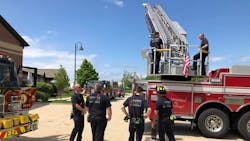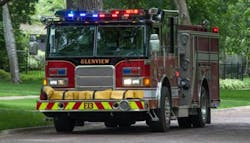Study: New Shift Model, AVL Will Improve IL Department's Responses
Glenview officials recently were presented with a lengthy review of the village’s fire department and received suggestions from consultants to keep in mind moving forward.
The study, which was conducted over the past year or so, examined various department operations, including demand, response times and resource utilization. At the Sept. 15 Village Board meeting, a consulting team from Missouri-based Fitch & Associates presented the report to officials along with their suggestions.
The study and consultation, which cost the village about $50,000 in total, is part of an effort to increase efficiency and improve services while reducing costs, officials said.
“The overall purpose of the study was to develop a data-driven analysis to help us identify opportunities … for improvement and ensure that our service delivery model is best aligned with current and future community needs,” Village Manager Matt Formica said.
The fire department currently uses five fire stations around the village and provides fire and emergency medical services for a service area that’s about 22 square-miles large.
In 2018, the department responded to more than 8,600 incidents that fell into two main categories, fire incidents and emergency medical service incidents, as well as a smaller category of hazmat, rescue and other calls.
Out of those responses, EMS calls accounted for a large majority over calls reporting a fire. Consultants said this is common for the Chicago metro area where fire departments are also largely responsible for emergency medical services.
According to the consultants, the fire department is doing well overall, especially compared to other “similarly situated” communities. In the future, however, they said the demand for services may increase and the village will eventually need to make decisions to improve operations, add resources and allocate them appropriately.
“The village has a very strong fire department; you can be very proud of it,” consultant Bruce Moeller said to the board. “There’s some opportunities here to make it even a little better and to prepare it for whatever events may be happening in the future.”
The top suggestion from staff and consultants was to implement a Medical Priority Dispatch System, a system in which 911 dispatchers ask certain questions over the phone to identify the appropriate type and severity of incident.
The fire department currently sends a minimum of one ambulance, staffed with two personnel, and one fire engine, staffed with three personnel, regardless of the type and severity of each call. Through the use of this system, according to officials, the department could reduce its use of some resources and increase availability of personnel.
According to the report, the village has had the technology for the system for a number of years but hasn’t fully implemented it to determine response approaches.
“That was a very safe and conservative approach,” Formica said of the department’s current operations. “It didn’t really look at some of the data and the analysis that this study has provided.”
Village officials and consultants said the change wouldn’t affect responses times but that it would just cut down on “unnecessary resources” on a majority of calls.
“If I break my arm and I’m home and I call the ambulance, an ambulance is still going to come, it just might not have a fire truck,” Trustee Deborah Karton said during the meeting. “So from the user standpoint, which is me saying my wrist hurts, the level of service as a resident doesn’t drop at all.”
Glenview firefighter Vince Spalo shared an opposing view on the proposed change during public comment, saying that the system sounds good in theory but that the information given over the phone is “only as reliable as the caller on the other end of the line.”
“If your loved one falls, are you sure why?” he said to the board. “Is it simply a fall or a stroke or a seizure? Are you panicked? Grief-stricken? Can you communicate accurately in that moment? Is this person large, which will require more people to assist moving them? Why would you want less people coming to help you in your time of need?”
Another suggestion from consultants was the use of adding 12-hour shifts during peak hours to optimize staffing and reduce the need for overtime. The current work schedule for shift employees is 24 hours on-duty followed by 48 hours off-duty. Rather than fully change that model, the consultants recommended using 12-hour shifts for growth and other needs.
“The trick is finding what’s the right base 24-hour service level and then manage all of your growth and enhancement through the 12 hours,” said Steven Knight of Fitch & Associates.
Other suggestions included the use of automatic vehicle location, further examination of turnout times, technology improvements and changes in workload. They looked at the possibility of cross-staffing vehicles and increasing mutual aid between communities. Glenview seemed to give far more mutual aid than it received in 2018, according to the report.
“That’s absolutely something we want to explore is working with all of our neighbors, whether it’s Northfield or Wilmette or Northbrook, and have a reciprocal automatic response agreement with them as opposed to the lopsided ones we currently have," fire Chief Tony DeRose said of mutual aid agreements. "We can definitely reach out and foster a relationship with them.”
The board made no official votes but gave their approval for village staff to move forward with changes like implementing the Medical Priority Dispatch System, and they requested more information on cross-staffing, mutual aid and the use of different stations and vehicles across the department.
———
©2020 The Daily Southtown (Tinley Park, Ill.)
Visit The Daily Southtown (Tinley Park, Ill.) at www.chicagotribune.com/suburbs/daily-southtown
Distributed by Tribune Content Agency, LLC.

